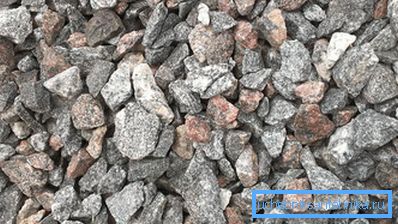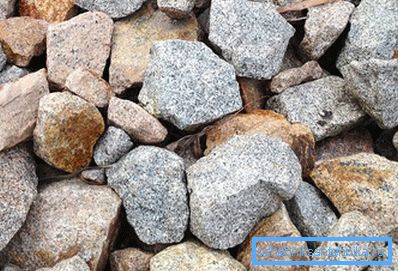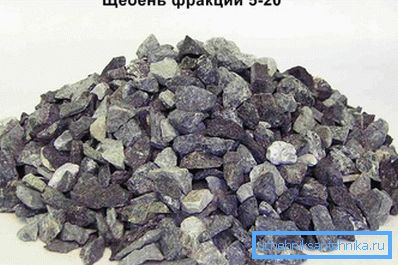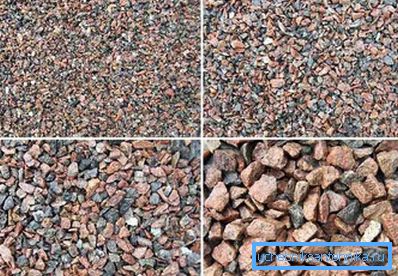What rubble is needed for drainage: fractions
An integral part of the structures of the device drainage systems is the filling of gravel. This material is an important component in the proper operation of drainage. Crushed stone is made from different rocks, which are crushed into stones of different sizes.
Characteristics of crushed granite
For the extraction of crushed granite rock of high hardness is first blown up, then crushed and sieved. It has the following properties:
- extremely high frost resistance. The material can serve for an unlimited time, since it is not destroyed by any frosts;
- high strength - 1 cm of the substrate is practically not damaged by the impact of a mass of 100 tons;
- relatively high density. In the mound, it is equal to 1.4 t / m ?. According to this characteristic, granite rubble surpasses other analogs.

Granite rubble has a number of specific advantages.
- The drainage system with a filling of such material is quite long, as the boundary rubble is strong and hard.
- Since the material is frost-resistant, nothing will happen to it in open-type drains.
- Granite rubble is a homogeneous material, which is obtained by crushing hard rocks. It contains no clay fragments and dust, as well as other particles that can be washed out with water. Therefore, granite rubble is a reliable filtration material and with its help, for example, a septic tank drainage is arranged.
- The process of obtaining material by crushing contributes to the formation of angular stones that are well interlocked. Because of this, it does not move.
- Granite rubble is harmless to humans, it belongs to the first class of security.
- The price for it is higher in comparison with analogues from other materials, but this type of backfilling pays for itself due to its quality characteristics and long service life. When constructing a closed-type drainage system, the use of this material brings significant savings, since the cleaning of a structure is very rare.
Tip! Despite the advantages, ideal in the application of granite rubble can not be called. The high strength of the material has a reverse side - so that the stones do not push through the drainage pipes, the latter should be wrapped in a protective bandage. In addition, sometimes granite quarries have an increased background radiation, so purchased gravel must be checked with a dosimeter.
Properties
Gravel crushed stone differs from granite in that it is produced by crushing sedimentary, inorganic rocks, so its structure is friable. Gravel stones are rounded in shape. Gravel rubble has the following properties:
- frost resistance of gravel material is high, but 2 times less than granite. Frosts are not terrible for the stone itself, but impurities do not withstand temperatures below –20? С. With significant frosts, the material cracks, while the substrate becomes dusty;
- high strength - the layer does not collapse under a load of 80 tons;
- clay fragments make up 0.6%;
- weak breeds contained in the amount of 1.5%.
Tip! Compared to granite, gravel rubble is less durable, but its cost is more affordable. Moreover, from the point of view of environmental friendliness, it is less radioactive, and therefore safer.

Although the gravel material is also crushed, like granite, the corners of its stones are sharper, so this crushed stone filters better.
Tip! The looseness of the material plays a negative role, since clay fragments will be leached from it. This, of course, will lead to clogging of perforated pipes with time, causing the throughput of the drainage system to deteriorate, and this in turn will lead to the need for its frequent cleaning.
Gravel rubble shows itself well when draining a site, so it is better to use it as a foundation drainage, and not for the manufacture of concrete. When constructing the foundation, you additionally need to add a sand substrate made of sand, the layer thickness of which should be 0.1 m. Then the sand will take on some of the negative effect of water on the foundation, and this factor will be felt to a minimum.
Use of dolomite rubble
The origin of dolomite rubble is not much different from granite. It is mined by the same methods and is slightly different from the granite counterpart - calcite is present in the dolomite material. In addition, the impurities in the rock in the form of quartz and iron oxide give the material different shades - from gray to brown, which makes this stone visually attractive.

Dolomite stone is different:
- low frost resistance. Due to impurities in large quantities, the stone loses its properties when the frost is –10? С;
- instability strength, which varies for the substrate from 50 to 150 tons per 1 cm. The strength depends on the amount of those or other impurities. The crushed stone of brown color, differing in the increased content of metal, is rather strong;
- clay is contained in the material of 0.25%;
- the inclusion of weak breeds is 5%.
Dolomite crushed stone has a comparative environmental friendliness, low cost and relatively good strength.
Tip! The lack of dolomite crushed stone is the presence in the material of metals, which form salts during oxidation. As a result, under the influence of its own weight, the baby is formed.
Fractions

Depending on the size of the stones, the fraction of rubble is divided into several types.
- Screenings up to 0.5 cm in size. It is not suitable for drainage, since such fragments are easily washed off with drainage waters.
- Stones ranging in size from 0.5 to 2 cm are not used for drainage, since such fragments are expensive and are used in the construction of concrete structures.
- Fractions from 2 to 4 cm are most required for drainage. Such stones are relatively inexpensive and drainage is arranged with their help.
- The category from 4 to 9 cm in size can also be used for the drainage system, but an excavator is used when backfilling material in a trench.
- Fractions from 9 to 30 cm are decorative stones. They are interesting only as elements of landscape design.

Crushed stone of a different origin and fractions has the mission in construction. Different materials can be used for the construction of the drainage system, but crushed stone of the middle fraction is best suited.